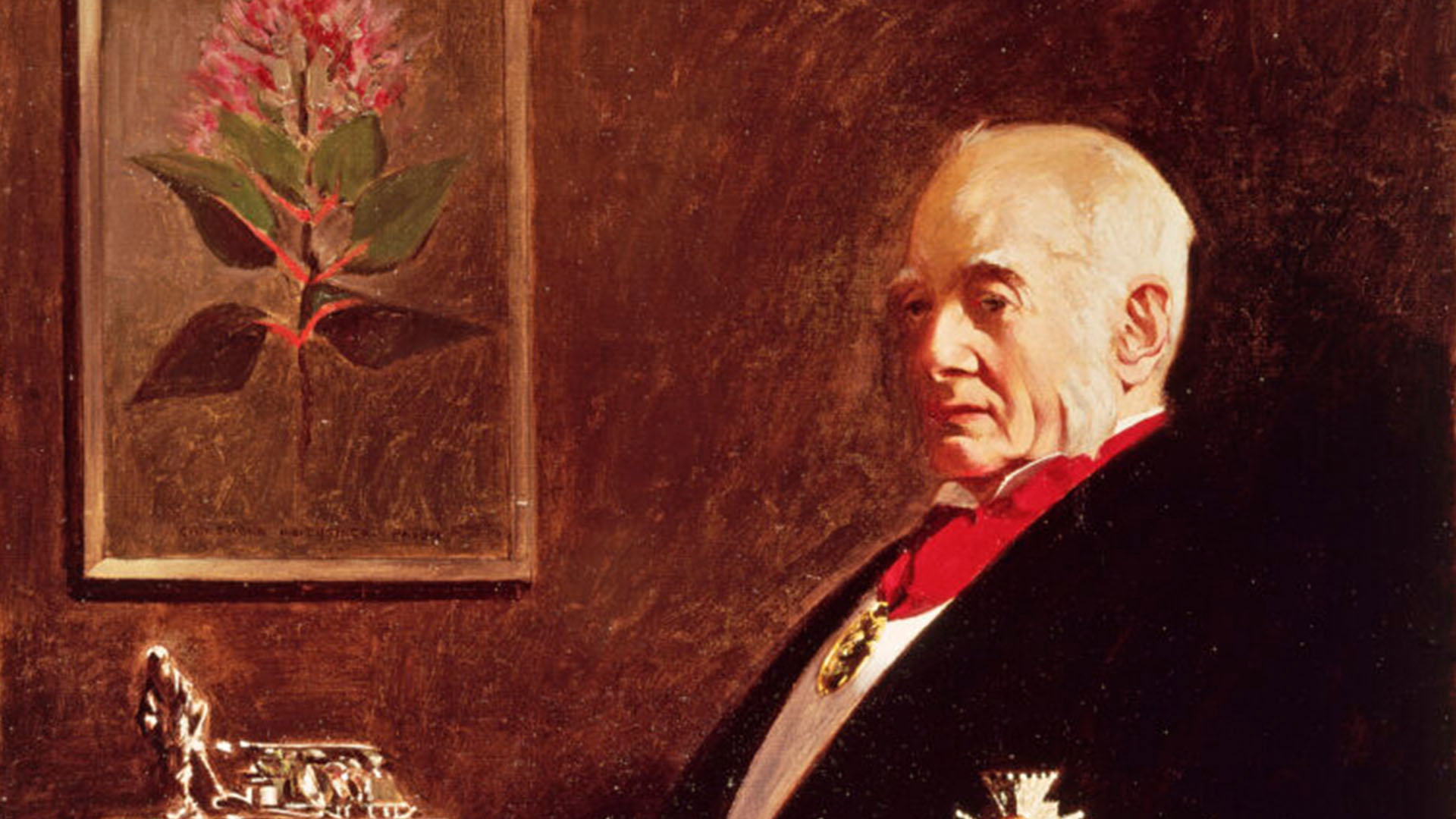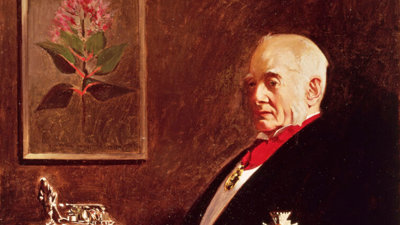Clements Markham (1830-1916) was born in 1830 in the Yorkshire village of Stillingfleet, where his father was the local vicar. In 1838 Markham senior, now Canon Markham, became rector of the church in Great Horkesley, near Colchester so the family moved south. One year later Markham started school at Cheam where he became interested in geography, and in particular polar exploration.
In 1842 he started Westminster School where his interest in geography was encouraged. At a dinner party given by his aunt, the Countess of Mansfield, he met Rear-Admiral Sir George Seymour, Lord of the Admiralty who asked if he would like to join the Navy and see the world.
Markham joins the Navy
Markham was enthusiastic and in June 1844 he enrolled as a naval cadet. His first ship was HMS Collingwood. On the 20 July, his 14th birthday, Collingwood sailed from Portsmouth Harbour with Markham aboard.
Life at sea proved a disappointment and after service in the Pacific and the Mediterranean he was thinking of leaving the Navy when a chance encounter with Sherard Osborn, an old friend, changed his mind. Osborn was due to take command of the steam-tender, Pioneer, as part of an expedition in search of the missing polar explorer, Sir John Franklin.
As Osborn talked about the coming expedition and the chance for adventure Markham was filled with enthusiasm and he lost no time in getting himself transferred to HMS Assistance, one of the principal search ships. The expedition sailed in May 1850.
At the conclusion of the search expedition Markham faced a return to regular naval duty, a prospect which did not delight him and so he decided to leave the Navy and seek adventure elsewhere.
Turning quinine into gold
In 1852 he travelled to Peru with £500 his father had given him. He reached Cuzco in March 1853 where he spent some time researching Inca history and describing the architecture and Inca ruins in the vicinity.
On one trip out to some nearby ruins he ended up in area of San Miguel, La Mar, Ayacucho where he learnt about the medicinal properties of the cinchona plant, the only economically viable source of quinine.

In 1859, having joined the India Office as a civil servant, Markham put forward a plan for transplanting cinchona plants from Peru and Bolivia to India where they could be grown in plantations to produce quinine. His superiors approved the plan and put Markham in charge of the mission. He arrived in Lima in January 1860 accompanied by the botanist Richard Spruce.
They successfully extracted sufficient plants to begin plantations in India, Sri Lanka and Burma but many of the original plants failed to flourish and were eaten by insects. Richard Spruce brought back further examples which were more suitable to conditions in India
Twenty years later Markham’s vision was realised as the cinchona plantations were producing 220,000 kilograms of quinine bearing bark. Markham was rewarded with a grant of £3,000 from the British government.
Markham's role in the Society and push for Arctic expeditions
Markham retained an interest in polar exploration and used his position as Honorary Secretary of the Royal Geographical Society (1863-1888) to press for another Arctic expedition. In 1875 he got his wish as the Admiralty launched an expedition to try and reach the North Pole via Smith Sound.
Although it started well and Markham’s cousin, Albert Hastings Markham, achieved a new farthest north at 83°20’N, the expedition was not a success, scurvy became a major issue and they were forced to return home early. Questions were asked in Parliament: how could such a well-equipped expedition achieve so little?
The National Antarctic, or Discovery, Expedition
In 1893 Markham was elected President of the Society, a post he held for twelve years. From the start of his presidency Markham set his sights on organising a major Antarctic expedition.
In 1895 the Society hosted the Sixth International Geographical Congress from which came a resolution to give priority to Antarctic exploration. Soon after, Markham began planning a British expedition to the southern continent. This became the National Antarctic Expedition, or Discovery expedition which was led by Captain Scott between 1901 and 1904.
Markham kept a diary for his entire life and the Society is fortunate to have many of his diaries in its Collections.
Controversy and criticism
In 1867, during his time as head of the India Office’s geographical department, Markham was selected to accompany Sir Robert Napier’s punitive military expedition to Abyssinia. Markham was attached to the mission’s headquarters staff with responsibility for survey work.
Markham accompanied the final storming party to Magdala and was one of the first to enter the house of Tewodros II, ruler of Abyssinia who had committed suicide when it became clear that the British were going to defeat his forces.
After the battle the commercially valuable artefacts were sold in a mass auction to the soldiers who had taken part in the expedition. Many of these treasures subsequently found their way into the collections of British museums.
In recent years the call for these stolen treasures to be returned has become much more vocal and sustained and some artefacts have already been repatriated.
Markham's oil on canvas portrait in our Collections is by artist George Henry (1858-1943).
Further readings
Baigent, Elizabeth. "Markham, Sir Clements Robert (1830–1916), geographer." Oxford Dictionary of National Biography.
Driver, Felix. Geography militant: cultures of exploration and empire. Oxford: Blackwell, 2001.
Blanchard, Peter (editor). Markham in Peru: the travels of Clements R. Markham. Austin: University of Texas Press, 1991.
Williams, Donovan. Clements Robert Markham and the Geographical Department of the India Office in The Geographical Journal 134 (September 1968): pp. 343-52.
Markham, Admiral Sir Albert. The life of Sir Clements R. Markham. London: John Murray, 1917.
